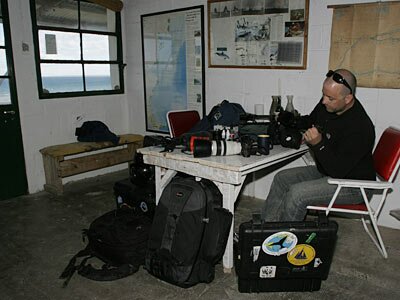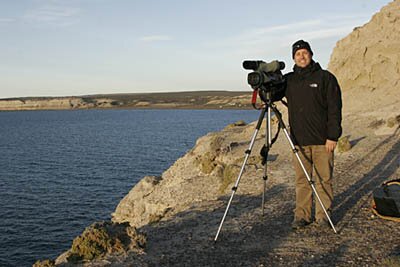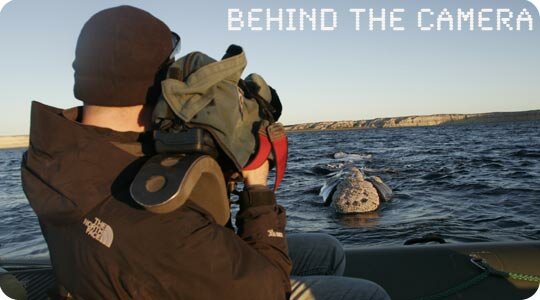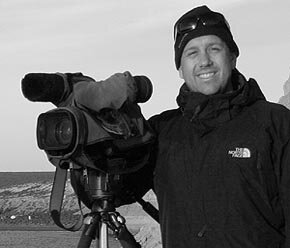Production Notes - Southern Right Whales of Argentina
From the start we wanted to film this project in high definition (HD). Researching what type of HD, was the most time consuming part of planning. For months, I have been following a lot of websites to keep up with latest trends - like HDforIndies and StudioDaily. In 2006, I attended NAB in Las Vegas to get a better feel for the affordable technology out there and to get my hands on the latest technology that might be available…

The past couple of years have seen the development of some new exciting technologies in HD and the reduction in price of cameras whereby high-quality could be obtained with minimal cost. But there is a big difference between what is defined as HD as HDV. The choice between the two would prove to be very costly in the end in many ways (but that is for the next post!).
We knew we were going to edit and deliver the program in 16x9 PAL DV and deliver it on DVD. However, we wanted to film in the highest resolution possible to archive the footage for future use. So the most inexpensive way forward was to film in HDV on a 'prosumer' camera, and edit the project in DV - downconverting the footage from within the camera.
Another limitation we had was our equipment for post-production. All of our editing would be done on my MAC G4 powerbook with an external 500gig Lacie drive. The post-production would take place in a variety of environments - in hotel rooms, in airport lounges, even in my brother's apartment in Brooklyn, NY.
Mobility was our constant theme in this project. We have had a lot of experience with producing short documentaries with limited equipment and resources using minimal field equipment.
So our post-production path was going to be a very simple one. We would log and capture clips in Final Cut Pro (FCP), organize the types of shots we were obtaining (while trying to capture behaviors of whales on our master list - much easier said than done!). We would then create an edit in PAL DV. We were writing the script, adapting parts of it to the images we were capturing, so it was a very loose process at times. It was important to us to capture the spontaneity of the life of researchers studying whales. Genevieve and I researching whales for 6 years previous, we knew that the best stuff captured on video would be the small surprises, where you just had to let the camera roll and let the chaotic scenes unfold before your eyes.
So, parts of the post-production process took place during the production. While in Argentina, I was trying to create simple scenes to help build a story around the script Genevieve was writing. Then, I would create a more detailed 'offline edit' in FCP. This was important because I could then create an 'online' and color correct at a later time (if that time ever comes!). Because of the budget and timeframe, we felt that this was the best way forward.
TOOLS
The terrain and the weather of Patagonia, were going to dictate what type of equipment that we brought with us to film southern right whales. In the end, I brought two cameras, a Canon XL H1 and the Sony Z1 with an Amphibico underwater housing.
Why two cameras on a limited budget? Well, we owned a Z1 already and we ended up purchasing the Canon XL H1. I am a big believer in owning your own gear (if you can afford it). We had a little money saved up, and I just loved filming on my old Canon XL-1. It was a great camera to film on the ocean, because of the image stabilizer built into the lense. For filming on the ocean, it is fantastic.
However, the XL H1 is a much different camera. Because you are filming in a higher resolution, I found the eyepiece very difficult to find focus. Even with the enhanced 'peaking' feature, which creates a grainy like image to help aid focusing, I would spend as much time as possible tweaking this. I ended up filming using the autofocus feature at times, when the action was important to capture. For example, when in a zodiac filming a mating group of southern right whales, I would sometimes set to autofocus, and worry more about balance, exposure and framing. When I was able to take my time to film, I would spend extra time with the focus. Unfortunately, because of the budget, I was not able to bring a portable monitor with me, which I learned over the weeks, even shooting HDV, is so vital.
Over the period of 6.5 weeks, there were four areas that we were permitted to film southern right whales. All of them had their own challenges as discussed in my previous post - filming from the cliffs, filming from the beach, filming from a zodiac and filming underwater.
-
Filming from the cliffs - The cliffs of Peninsula Valdes can be up to 60 meters high, and give you a great perspective of the animals below. Spectacular cliffs and a smaller remote field observation post called 'the cliff hut' surround the research camp that is used by ICB every year. This is where researchers can observe and take data on whales for hours at a time.

So filming here would require the use of some telephoto lenses. Since all of my photography gear is Canon, I could use my Canon lenses (in theory) with the XL adaptor for the Canon XL-H1 camera, and get very close to the animals. I could use the long end of my Canon 100-400mm zoom lense and with the 7x extension, theoretically turn it into a 2700mm lense!
Did it really work? Well, yes and no. Because Patagonia is known for its wild weather, it can be an extremely windy place. When the wind is blowing (often times at 20-25 knots), it would shake my zoom lense tremendously even on a steady tripod.
However, this worked when the weather was calm. When there was the slightest amount of wind, there would be too much slight vibration, which would render the attached XL lense totally useless. However, I was rewarded by just on a number of occasions where I captured some nice footage of one of the major conservation issues southern right whales face in this area - attacks by kelp gulls.
Kelp gulls attack southern right whales, and feed on the skin. This only happens in Argentina, and you can see circular wound with blubber exposed. Have a look at the film - it is terrible to watch it happen. The reaction of the whales can be very disturbing - especially in an area which is so important for resting. Some of the wounds that develop in the calves can be quite extensive.
Another behavior I wanted to document with using a long lense was 'breaching' - when a whale launches itself clear out of the water. Usually southern right whales may breach when the weather is rough, or after kelp gulls attack them. Often, when it was calm, it was a period of rest for southern right whales. Of course when it is calm, it is the best time to film. So there was a lot of waiting, and patience involved in filming southern right whales.
-
Filming from the beach - At high tide, southern right whales get very very close to the shoreline with their calves, allowing you to put a tripod close to the ground and film. It is a very unusual to get this close to any species of cetacean. In the right light and weather conditions, it is possible to capture very stable imagery.
Mother calf pairs often times will rollover each other, creating a wonderful display only 10-20 meters away! I was able to get some great shots from the beach. I do admit, these were my favorite times to film right whales. I would look around the camera, and take some time to enjoy being in the unique area surrounded by whales.
-
Filming from the Zodiac - ICB have a 14-foot inflatable zodiac that they use for the research. Unfortunately, it had some engine problems this year, which limited its use a bit. Also, it can only hold 4 people - usually 3 people if I was filming or someone was biopsying southern right whales.

So it was challenging at times, when the weather was calm, to gain access to it. Often, I would tag along and try to document some behaviors of southern right whales from the boat and be in the background of the researchers doing their work. It was difficult this year, because the weather was terrible on a regular basis. So we could not get on the water as much as we could have liked.
It is a fine line you trend when documenting scientific research, they have to get their data, and you have to get your shots, which help tell the story and raise awareness about the whales, conservation issues and the researchers. Along the way, there is always going to be compromise. But it is important, not to be in the way, be positive and enjoy it. I always find by trying to work this way, it is a much more enriching experience for everyone, and at the end of the day, everyone eventually gets what they need!
-
Filming underwater. This was the most challenging of environments to film southern right whales. First of all, I had to obtain a special permit to be in the water filming whales from the Argentine government. This took some time to do, and ICB did a great job of obtaining it for the project.
Because of logistics with the research program, we started filming underwater during the final two weeks of filming. Honestly, I was a bit nervous about it, because over the 6.5 weeks we were in Peninsula Valdes, it would seem to work out that we would film 1 day in every 5.
The weather really limited the use of the zodiac so much, at one point we were discussing hiring another larger boat to film. Also, the weather in Valdes changes rapidly, one moment it could be calm for a couple of hours, then you find yourself with the wind increasing to 20 knots, and would have to go back in to the research station.
In Peninsula Valdes this time of year, the sea is very cold and the visibility is incredibly poor. The whales can be very, very curious, so they will approach you, but they can be difficult to see. Because of the visibility, I often was 'shooting from the hip', where I would not look through the viewfinder of the camera and the underwater housing. I would set the camera up for 'auto-everything' (exposure and focus) and just try to document anything in front of me, while attempting to maintain my balance (and cool) among aquatic mammals that can reach a size of 45 feet and weight over 20 tons…
Most of the time while filming whales, I like to have an external viewfinder above the housing so I can watch what is happening around me, while getting a good view of what I am filming underwater. However, in the case, the camera could 'see' better than I could underwater.
We planned to film 5 full days, and ended up doing three days of 2 to 3 hours sessions. In all cases, the weather and wind picked up where we would have to stop.
So as with any experience, it is important to listen to the people who are the experts in an area, no matter how much you want to, again, patience is so important with 'getting a shot'. This is where Dr. Mariano Sironi was fantastic. He was the official observer and he is very experienced with divers in the water around whales.
Luckily, my first encounter with southern right whales was with a juvenile female, who seemed more curious about this large human floating around in a big black wetsuit and odd-looking yellow mask and snorkel!
She moved by me very slowly, but because the visibility was only 3 meters at most (on a good day). When the whale was in sight, she would emerge from the cloudy water very, very quickly.
This whale first approached me, close to my camera, and we were almost nose-to-nose. For about 45 seconds she floated like this, a meeting of two species - one its natural environment, the other an honored visitor, a new terrestrial friend.
She would circle around and come back and just pause in front of me. I did not have to move much in the water. I just waited for her to approach me, and I never swam after her.
After each pass, she approached me closer and closer.
Often, I would see her enormous eye gazing back at me, watching me float by with this giant silver box tipped with a giant round glass on its periphery. I wonder if she was looking at her reflection in my lense?
Filming right whales underwater was absolutely mesmerizing. A couple of times, I was so in awe, that the distant voice in my head would remind me to watch out for the rest of her body moving past. A few seconds after the head pass by, the flukes would emerge from the murky green abyss, and sweep past me like a giant fan. During one pass, she even raised her fluke over my head as she cruised by.
At one point during filming, she turned belly up right in front of my camera with her pectoral fins gently sweeping past the lense. Nothing could describe this - it was on of the gentlest acts I have ever witnessed from a wild animal or a supposed tame species like a human.
I was able to film a number of whales during those three days, but the first encounter was the most memorable and enjoyable. It was this day, the sea calmed for a brief window of time and I was just in the right place at the right time - a common theme for wildlife filmmakers in any environment.
All the senses break down in encounters like these with wildlife. I feel truly honored to have spent 45 minutes face to face with a southern right whale in its environment, in its world, in its home.
FILMING EQUIPMENT-
- 1 x Canon XL-H1 - Canon's latest HD version of the XL-1 - a great DV camera that many wildlife filmmakers used to produce material on a budget. We ended up purchasing an H1 in the end, because of a number of reasons. I wanted to film the documentary in HDV, I wanted to use the built-in image stabilization, which is very very important when filming on a zodiac. I always use a zoom lense when filming whales because often you have to frame what you are filming very very quickly.
- 1 x Sony HVR Z1 -This was a good choice of camera to put underwater. It was great in the murky seas on Peninsula Valdes and I will use it again.
- 1 x Amphibico Phenom Pro Digital Marine Housing for the Z1 with a wide angle lense. I orginally bought and old piece of stock, which had vignetting in the lense. I sent it back to Amphibico and they promptly fixed it. It is my understanding that this is not a problem now with this housing, but make sure to ask any UW housing dealer if there is vignetting in their lenses.
- 1 x Lowel Caselite - A great light and fantastic for interviews.
I really like fluorescent lights for interviews, But, the best thing about it is that it works on both 110v (US) and 220v (South America / European /Australian ) power sources! So, for traveling, it is a great light to have. However, when I was picking up my luggage in NY, the handle popped off somewhere between the plane and the baggage pickup!
- 1 x Litepanels Mini with a built in battery.
I use this as an 'on' camera light and love it. They have recently come out with a 1-foot by 1-foot light I would like to experiment with but is a bit expensive. This also runs on both 110/220-volt power.
- 2 x Sennheiser K6 microphones (ME66), boom pole, windscreens. I have used these mics for years and love them.
- 1 x Wireless Mics (Azden) - I have had a lot of problems with these mics and the particular brand I own. They are low cost wireless lapel mics, and I will not use them again.
- 1 x Manfrotto tripod (with a 501 Video head) - I use it both for video and have another head for photography. It is a little light for the XL H1 but works fine on a budget.
- 1 x Lacie 500gig hard drive (firewire 800) Big Disk Extreme with triple interface. I have had this drive for a couple of years, and it works well in the field. Pretty tough,and it has never failed me yet! I used to own a 250 gig lacie 'porche' drive, and had problem with it overheating. However, the big disk, has been wonderful in may different environments!
Photo equipment -
I did not bring alot of photo equipment with me on this trip; just a digital body with a couple lenses and some Fuji Provia slide film.
- 1 x Canon 20D with 4 batteries. I had a 17-35mm 2.8 lense and a 100-400mm IS 4.5/5.6 lense. I love the 100-400 L IS lense, and it is my primary lense when photographing wildlife from a boat or zodiac. The 20D is a fantastic camera and has survived some big waves too.
- 1 x Canon 580Ex flash and softbox
- 3 x 1 gig cards
- 1 x Canon EOS 1V - It is pretty battered from too much time on the ocean. But when I want to shoot really wide ( because I cannot afford a 5D or EOS 1D mark II right now) or shoot film this is just a fantastic camera body!
- 1 x Nikonos Underwater Camera & 20mm lense - our tough 'old skool' camera with a Nikon strobe. It is probably going to be the last trip before we officially retire it to the bookcase. I love it, but it is time to invest in a digital underwater kit.
FINAL THOUGHTS?
So, did I have any regrets in the production of Southern Right Whales of Argentina?
Well, there were two - filming in HDV and some audio issues.
First the sound - I usually take a big 'blimp' with me, however it was boxed up in storage in Melbourne, Australia. I had no way of getting it sent over before the trip. With some last minute purchases I could not afford purchasing a new one and I ran out of time to search for a used one. Peninsula Valdes is a VERY windy place. Even with some protection of my canon microphone with Lightwave windsock (EQ102) you need a blimp to record sound with an external shotgun mic to really make it worthwhile especially if the wind is over 15-20 knots!
Using HDV - Since coming returning from Argentina, I have looked at some of the footage on an HD monitor and the detail is incredible. However, the path to post-production to edit an HD version is a bit more time consuming and expensive.
I have done some editing in final cut pro in native HDV. When you start to color correct it, well, it can just fall apart. In the future, I will most likely do an online edit of the clips and recapture clips uncompressed through a Miranda's HD-Bridge DEC - but first I'm going to have to upgrade my editing equipment.
The XL H1 is a great all-round camera for the price because of the lense. For filming on the ocean, the image stabilizer is fantastic - just make sure to turn it off when it is mounted on a tripod. While I did learn how to use the canon viewfinder because of the 'peaking' feature, it took a lot of time to try to focus. Especially during the interviews, I wanted to blur the background with the shallow depth of field. Without taking the time, it could have been a disaster.
Also, I learned that you must have a monitor with you in the field that can map every single pixel of an HD single. When you are looking at monitors, make sure to check the native resolution. Some models from Panasonic are below the native resolution of HD but have an 'HD zoom” feature which allow you to zoom into the signal and pan around the mapped pixels. A French cinematographer we met in Piramides, had one with him, and it looked fantastic!
It is so important, and every article I have read stresses how important a monitor is when filming HD. This was so apparent when I filmed right whales underwater in very murky water. There were times that I could not position myself properly with the sun behind me in relation to filming a whale. When the sunlight hit the dome just right, it lit up every minute bubble. I could not see in the viewfinder - even after I wiped the dome with my hand. Luckily, this occurred only a few times, but on one important shot. It is still usable, but I still curse myself over it!
Either way, every experience like this is a learning experience! Along the way, it was challenging, draining, enjoyable, and of course, a lot of fun.Labels: Canon XL H1, Chris Johnson, Field Production, Film Production, Filmmakers for Conservation, HDV, southern right whales of argentina, Wildlife Filmmaking


